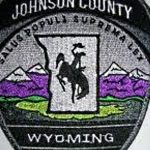News – Sheridan Media

May is the month of Memorial Day, when American Flags are placed on the graves of those who have died, many in the service of our country. June is the month of Flag Day, a day set aside to celebrate the “Old Glory,” the Flag of Our Country.
In this column, we will look at some interesting facts about our flag, the symbol of our country.
Every school student has heard the story of Betsy Ross, who sewed the flag for George Washington. Although this story isn’t completely accurate, there are still elements of truth in the legend.
In this story in the Green River Star, June 6, 1919, it tells one how to craft a flag for themselves, as well has having some flag history. Most young girls in 1919 learned to sew, many were excellent seamstresses.
Like Betsy Ross A Girl of 1919 May Easily Construct Her Own Starry Flag. The American flag is one of the easiest in the world to make, since all of its parts are in straight lines. Any schoolgirl who is able to sew can make a flag for about one-half of what it will cost her at a store, and still have a stronger and more durable one when she has it finished.
There are two principal ways of proceeding in the making of an American flag. The one used by most persons is to determine first the width of the stripes, so that if the flag is to be made of silk, ribbon may be purchased of a standard width. From this the size of the flag may be determined. The second method is to decide either the width or the length of the flag and then compute the amount of material from the size decided upon.
Let us assume that we wish to make a flag from two-inch silk ribbons. since two-inch ribbon is a standard size and may be purchased at any dry goods store. Since the stripes will be two inches wide, the width of the canton, or the blue field, will be seven times two inches, or 14 inches, and its length will be the same, since the canton of the American flag is square.
The canton is also one-third of the length of the flag. Then the flag will be three times 14 inches, which equals 42 Inches and the width being 13 times two inches, or 26 inches. Thus, to use two-inch ribbon, one will have a flag three and a half feet long and a little more than two feet wide. Material Needed. The next thing is to determine Just how much two-inch ribbon must be purchased, so that the stripes may be made with little or no waste.
There are three full white stripes in the complete length of the flag, which equals 126 inches, and added to that will be the three short stripes, two thirds the length of the flag, or 84 Inches, making a total of 210 inches, or about six yards. For the red stripes, it is necessary to add one extra short red ‘stripe of 14 inches, which is about half of a yard.
Thus, for a flag made with two-inch ribbon, it will be necessary for the maker to purchase six yards of white and six and a half yards of red ribbon. The canton will be seven inches square and the stars may be made from smaller widths of ribbon. There must be 48 stars arranged in six rows of eight stars each. (notice when this flag would have been made. Hawaii and Alaska were not yet states) By using a ruler, the exact position of the stars may be determined and they can be easily cut if a paper pattern is made be forehand. By the second method, one deter mines the length of flag—for example, make the flag 21 inches long. By applying the same process of computation backwards, the size of the can ton will be seven inches square and the width of stripes one inch. The amount of material may be determined by the same calculations used in the first method.
The official origin of the flag with the 13 alternate red and white stripes, representing the United Colonies, in a blue canton, which was raised on Prospect hill, Cambridge, on the first day of January, 1770, has never been satisfactorily determined. It is commonly thought that the continental congress appointed George Washington, George Ross and Robert Morris a committee, authorized to design a suitable flag for the nation and that they called upon Mrs. Ross, who was conducting an upholstery business on Arch Street in Philadelphia. The confirmation of this report is not to be found in the Journal of Congress.
There seems to be little doubt that the American flag is a growth rather than a creation. Few of the writers have declared that both the stars and the stripes were derived from the coat of arms of ‘Washington’s family, which contains both devices, but beyond that coincident no other evidence has been produced to prove this.

Made Official Emblem. On June 14, 1777, the American congress in session at Philadelphia adopted the following resolution: “Resolved, That the flag of the 13 United States be 13 stripes, alternate red and white, that the Union be 13 stars, white on a blue field, representing a new constellation.” The credit of making the first flag is given to Betsy Ross. William J. Canby, a grandson of Mrs. Ross, declared that Betsy Ross was shown a rough drawing of the flag, which was explained by General Washington. She “objected to the six-pointed stars, and suggested that they be five-pointed.
General Washington is supposed to have redrawn the sketch, changing the stars to five points. At first Washington declared that the five pointed stars would be hard to make, but Mrs. Ross demonstrated that by one clip of her scissors she was able to make a perfect five-point star.
In 1912, the United States congress admitted Arizona and New Mexico into the Union and the stars then numbered 48. The law did not provide how the stars were to be arranged, and for a long time a considerable diversity existed in this respect. However, on October 20 of that year, the proportion was definitely fixed and the manner in which the stars were to be placed was determined. Since that time the same rule has held good, that of six rows of eight stars each.
Many meetings and events today open with the reciting of the “Pledge of Allegiance.” The pledge was written in 1885 by Union Army Captain G.T. Balch and promises allegiance to the United States.
An old version of the pledge appeared in The Laramie Boomerang, September 7, 1918


Here are some flag facts from the Wyoming State Tribune, Cheyenne, on June 14, 1918
Our Flag: Milestones Along The Path Of “Old Glory”
1777 — First displayed over a military post at Fort Schuyler, on the site of the present city of Rome, New York; 1777— First displayed on a vessel of war by the famous John Paul Jones, of the”Ranger;” 1777 — First carried into battle, on the banks of the Brandy Wine; 1777 — First hoisted over a foreign strong hold, when Captain Rathbone of the sloop of war Providence captured Fort Nassau, in the Bahamas; 1783 — First displayed in an English port by the schooner Bedford of Massachusetts; 1790 First carried around world, by the American ship Columbia; 1824 -First carried through the Straits of Magellan by the merchant ship Endeavor of Salem, Mass.; 1829 — First raised in California by Captain James P. Arther, a seafarer from Plymouth, Mass.; 1839 — First carried far beyond the Antarctic Circle by the pilot boat Flying Fish, of the Wilkes expedition.; 1844 — First carried around the world by an American steamship; 1848 — First displayed upon the Sea of Galilee, by the expedition of Lieutenant Lynch; 1853 — First displayed in Japan at the landing of Perry’s party in the bay of Jeddo; 1861 — First raised and kept flying on a public school by the high school of New Bedford, Mass.; 1867 — First raised in Alaska, on the transfer of that territory from Russia to the United States; 1868— Raised over the Midway Islands, in the Pacific ocean, the first acquisition ever made by our government m this manner; 1868— Planted on the summit of Mount Baker, 10,613 feet above sea level on the occasion of the first ascent of the peak by man; 1871-Carried into the interior of Africa by the Henry L. Stanley expedition; 1873— First raised on the summit of the Andes, by a party of American engineers engaged in rail way surveying; 1877— Unfurled for the first time in the far interior of China; 1917-Displayed on a European battlefield for the first time by the American expeditionary force in France.
In the Moorcroft Democrat on April 13, 1917, it gives brief instructions of how the flag is to be displayed.

So, when one sees the flags on graves on Memorial Day, or gracing our streets and buildings on Flags Day, we should give a thought to our flag, the symbol of Freedom throughout the world.
Last modified: May 18, 2025






